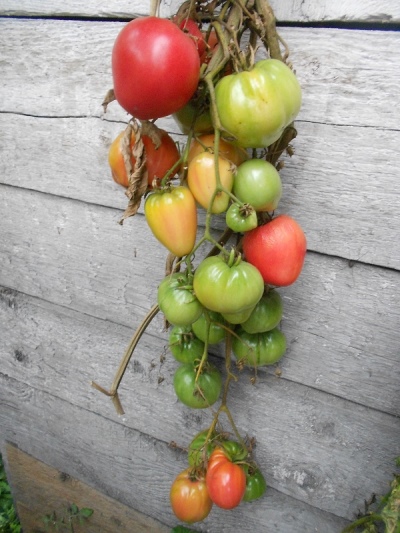
- Authors: Steinert T.V., Teplova N.S., Aliluev A.V., Avdeenko L.M., Volkova V.Yu., Chuikova Z.D., Shilova O.I. (LLC "Heterosis selection")
- Year of approval: 2021
- Category: grade
- Growth type: indeterminate
- Appointment: universal
- Ripening period: mid-season
- Growing conditions: for open ground
- Bush size: tall
- Bush height, cm: 200 and more
- Bush characteristic: powerful
Many gardeners, when choosing a variety of tomatoes for cultivation in summer cottages or personal plots, give their preference to the Loving Heart tomato. This variety is not picky about weather and climatic conditions and is easy in agrotechnical care.
Breeding history
Siberian breeders of LLC "Heterosis selection" worked on the development of this variety. The breeding authors were Steinert T.V., Teplova N.S., Aliluev A.V., Avdeenko L.M., Volkova V.Yu., Chuikova Z.D., Shilova O.I. Tomato Bull heart. The resulting variety Loving Heart is quite young; it was approved for use in 2021.
Description of the variety
Loving Heart breeders attributed to indeterminate, tall varieties. When cultivated in open ground, the height of the shoots reaches 1.8 m, when grown in greenhouses, the height of the bush increases to two meters or more. The bush is characterized by strong shoots, with an average amount of deciduous cover. The first flower ovaries are formed under 8 or 9 leaves. Harvesting begins 95-100 days after the start of the growing season. Leaves of medium size are slightly elongated and colored green.
The main qualities of the fruit
Loving Heart tomatoes have large fruits that exceed their parent's harvest. Its weight can be from 360 g to 1 kg with appropriate agricultural care. The unripe fruit is green, with a small spot on the stalk. When mature, the color of the fruit becomes crimson. The shape of a tomato resembles a heart, with faint, barely noticeable ribs. The thin skin protects the medium-firm, juicy flesh. When fractured, a granular structure can be seen. It belongs to the universal varieties, as it is suitable for consumption not only fresh, but also in salted and canned food.
Taste characteristics
The taste of tomatoes is pleasant. Delicate sweetish aftertaste diluted with notes of sourness, which gives the fruit a certain dignity. The rich aroma is retained even when canned.
Ripening and fruiting
Intermediate inflorescences begin to bear fruit from the second decade of June, and this period lasts until early August, so the variety can be safely attributed to mid-season. Fruits do not ripen very evenly, which increases the time of ripening and fruiting.
Yield
The variety is high-yielding, gardeners collect up to 15 kg of fruits from one well-developed bush, in exceptional cases the yield increases to 23 kg. One square meter of crop area can yield from 5.3 to 5.8 kg of ripe tomatoes. Outdoor crop yields are slightly different from greenhouse plants. This option gives a more bountiful harvest.
The timing of planting seedlings and planting in the ground
To obtain seedlings, seeds are sown from mid-March to early April. In order to get good planting material, you need to adhere to some agrotechnical rules. For the prevention of diseases in the future, tomato seeds are treated with a weak solution of manganese. They are briefly dipped in a solution, then washed under running warm water.
For quick germination, the seeds are soaked. To do this, use any fabric that constantly needs to be moistened. This process lasts approximately 11-12 hours.
In an open area, the finished grown material is planted in June, when the soil temperature exceeds + 10 ... 12 ° С. Seedlings are considered ready for transplanting 65-70 days after seed germination. The readiness of the planting material is easy to determine by the number of leaves (there should be at least seven) and a powerful stem.
The site must be protected from winds and drafts, well lit.
Tomatoes are planted in greenhouse soil from April to May.

Growing tomato seedlings is an extremely important process, because it largely depends on whether the gardener can harvest at all. All aspects must be taken into account, from seedbed preparation to planting in the ground.
Landing scheme
Young plants are placed at a distance of 30 cm from each other, a distance of 50 cm is recommended between rows.

Growing and caring
To get a good harvest, proper care is necessary:
timely and correct watering;
periodic feeding of plants;
preventive actions against diseases and pests.
Tomatoes prefer moderate watering 1-2 times a week. More frequent watering and stagnation of water near the root system can negatively affect fruiting.
Overdried soil also adversely affects the growth of the crop, since in this case the roots of the plant suffer.
The feeding of the Loving Heart is carried out in several stages.
The first feeding is done on the 10th day after the plants are transplanted into the ground, here fertilizers with a nitrogen content are appropriate.
The second feeding takes place during the appearance of the ovaries. Any mineral fertilizers are used. It is better to exclude nitrogenous fertilizers this time.
In the fall, it is necessary to carry out the main fertilization of the site. It is good to use humus or dung from pets.




A plant needs different micronutrients at each stage of growth. All fertilizers can be divided into two groups: mineral and organic. Folk remedies are often used: iodine, yeast, bird droppings, eggshells.
It is important to observe the rate and period of feeding. This also applies to folk remedies and organic fertilizers.



























































































